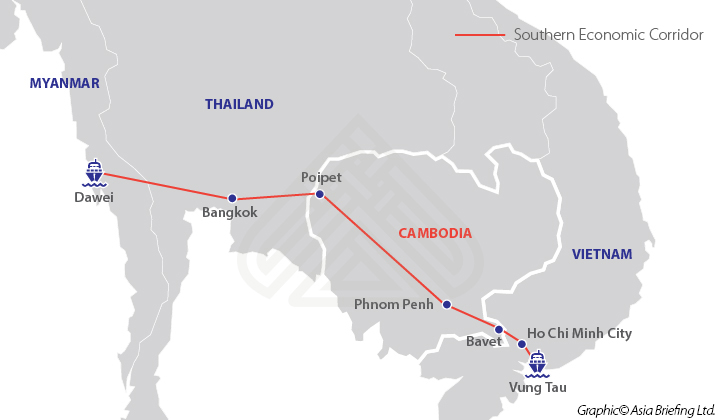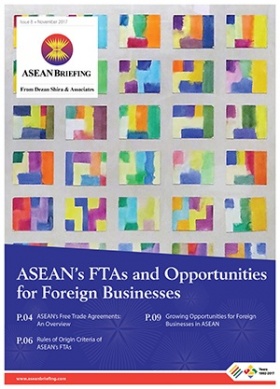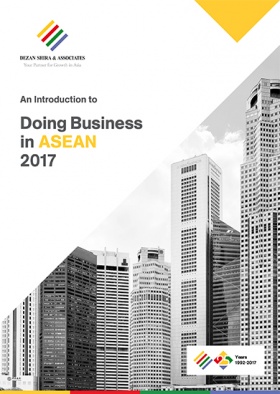The Southern Economic Corridor: Boosting Trade and Investment in Cambodia
Stretching eastwards from Myanmar through Thailand and Cambodia to Vietnam, the Southern Economic Corridor (SEC) aims to further integrate the Association of Southeast Asian Nations (ASEAN) by improving connectivity and trade. In Cambodia, new clusters are growing around border towns and in existing industrial hubs along the route of the SEC. Foreign businesses are investing in Cambodia, benefiting from both the country’s cheap labor pool as well as the improved connectivity brought on by the SEC.
SEC: A snapshot
The SEC is one of the many development projects initiated in the Greater Mekong Subregion (GMS). The GMS is a natural economic area loosely connected by the Mekong River – the 12th longest river in the world. The GMS spans an area of 2.6 million square kilometers and a total population of 339 million people, as of 2015. In 2015, trade within the GMS amounted to US$444 billion.
In partnership with the Asian Development Bank, the GMS Program for subregional cooperation was established in 1992 to facilitate economic cooperation and growth between Cambodia, China’s Yunnan Province and Guangxi Zhuang Autonomous Region, Laos, Myanmar, Thailand, and Vietnam.
The SEC’s principle route extends eastwards from Dawei (Myanmar) and passes through Bangkok (Thailand), Phnom Penh (Cambodia), and Ho Chi Minh City (Vietnam) before terminating at Vung Tau (Vietnam). Additional sub-routes bring improved connectivity between Cambodia and its neighbors:
- With Laos through Dong Kralor
- With Thailand through Poipet and Cham Yeam
- With Vietnam through An Dong Pech, Bavet, and Kep.
Additionally, a SEC subroute connects Cambodia’s capital Phnom Penh with the country’s Sihanoukville Port.
The SEC (one of the three ongoing economic corridor projects in the region) will make it easier for both domestic and foreign businesses to do business and access markets along its route.
Improved infrastructure and connectivity
Though still vulnerable to occasional adverse weather conditions, Cambodia’s highways now facilitate direct overland connectivity between Thailand and Vietnam. According to a 2014 study, freight travel from Bangkok to Phnom Penh through the SEC takes approximately 24 hours while passenger travel takes 11 and a half. Freight travel from Phnom Penh to Ho Chi Minh City takes roughly 14 hours whereas passenger travel takes 5 and a half.
The Phnom Penh aiport has already undergone upgrades, increasing its capacity to 5 million annual passengers. The airport at Sihanoukville – an important port city connected by a sub-route to the SEC– is currently undergoing upgrades to increase its capacity to 500,000 annual passengers.
The Neak Loeung Bridge (otherwise known as the Tsubasa Bridge) is the latest in improvement in connectivity with the SEC. Completed in April 2016 with development assistance from Japan, the Neak Loeung Bridge spans the Mekong River,connecting Cambodia’s Kandal and Prey Veng provinces while drastically improving the ease of traveling from Phnom Penh to Ho Chi Minh City.
Why Cambodia?
Cambodia is an ideal location for labor intensive and export-oriented manufacturing. Cambodia benefits from the European Union’s ‘Everything But Arms Scheme’ which allows underdeveloped nations duty free access to the EU’s market for all export goods.
Cambodia’s garments industry, for example, has attracted the attention of major players such as Adidas, Armani, the Gap, and Marks & Spencer. Cambodia possesses a large and low cost workforce. A garment worker’s monthly income in Cambodia, for instance, averages at US$153.
Cambodia remains dependent on imported inputs for manufacturing. Factories located near borders, or else on the SEC, can benefit from Cambodia’s relatively cheap labor and export incentives while easily sourcing inputs from neighboring countries.
In the first four months of 2017, investment in Cambodia’s construction sector increased by 43.3 percent. Cambodia’s growth is accelerated by industrial clusters near its borders which optimize Cambodia’s potential.
Growing industrial clusters in Cambodia
Poipet
Originally a small Cambodian border town and gambling hotspot for Thai nationals, Poipet is expanding with ambitions of becoming an automotive parts manufacturing hub.
Automotive manufacturers (predominately from Japan) are establishing factories in Poipet – taking advantage of the readily available low-cost labor and cheap electricity imported from Thailand.
Poipet currently possesses three special economic zones (SEZs): the Poipet O’Neang SEZ, the Sanco Poipet SEZ, and a new Poipet branch of the Phnom Penh SEZ.
Poitpet is located only 240 kilometers from Thailand’s Laem Chabang Sea Port – itself an important part of Thailand’s own Eastern Economic Corridor.
Phnom Penh
Phnom Penh is a major destination on the SEC. Phnom Penh specializes in light labor-intensive industries such as garments and footwear, food and beverage, and consumer products.
However, the new Kerry Worldbridge SEZ – situated just 20 kilometers away from Phnom Penh – aims to create a logistics hub and encourage more automotive and value added electronic production. The Kerry Worldbridge SEZ is a US$100 million project built on 155 acres of land.
The main SEZ in Phnom Penh as well as the most developed SEZ in Cambodia is the Phnom Penh SEZ (PPSEZ). The PPSEZ currently has an estimated 80 tenants and 15,000 employees. Notable corporations already present in PPSEZ include Coca-Cola, Toyota, and Yamaha.
Bavet
Bavet is situated along the Cambodia-Vietnam border and is located only 80 kilometers from Vietnam’s main commercial hub of Ho Chi Minh City. Aside from being a center for the readymade garment (RMG) industry, Bavet is also becoming a cluster for the production of watches. Companies engaged in manufacturing watches – whether the band or bezel – are clustering together to turn Bavet into a ‘watch village.’
Bavet currently possesses three principle SEZs: Manhattan SEZ, Tai Seng, and Dragon King. Though smaller, these border SEZs benefit from ease in ability to trade and source materials. Their proximity to Vietnam’s Vung Tau Port further increases their international reach.
Cambodia: Thailand plus one?
The establishment and ongoing improvements to the SEC are nurturing manufacturing clusters that benefit from improved logistics and connectivity.
Foreign businesses looking to establish manufacturing facilities in Southeast Asia can avail from incentives in Cambodia while simultaneously taking advantage of reliable sourcing of inputs and electricity from neighboring countries.Furthermore, the success of the SEC will stimulate intra-ASEAN trade – creating new access to an array of emerging markets. With increased activity along the SEC, Cambodia’s clusters will continue to grow, making Cambodia a new manufacturing hotspot of ASEAN.
About Us
ASEAN Briefing is published by Asia Briefing, a subsidiary of Dezan Shira & Associates. We produce material for foreign investors throughout Asia, including China, India, Indonesia, Russia, the Silk Road & Vietnam. For editorial matters please contact us here and for a complimentary subscription to our products, please click here.
Dezan Shira & Associates provide business intelligence, due diligence, legal, tax and advisory services throughout the ASEAN and Asia. We maintain offices in Singapore, as well as Hanoi & Ho Chi Minh City, and maintain Alliance offices in Bangkok, Jakarta, Kuala Lumpur and Manila as well as throughout China, South-East Asia, India and Russia. For assistance with ASEAN investments into any of the featured countries, please contact us at asean@dezshira.com or visit us at www.dezshira.com








